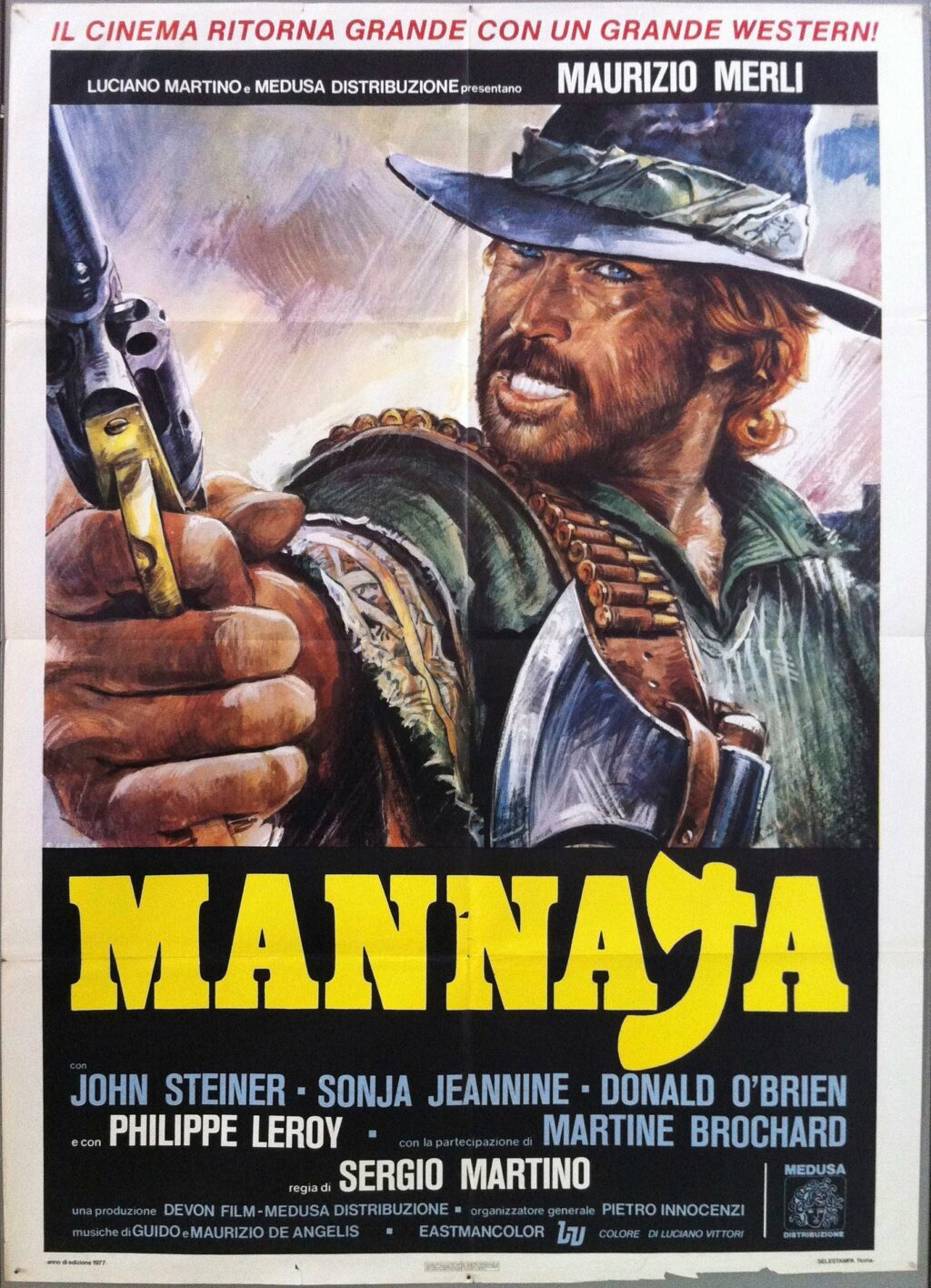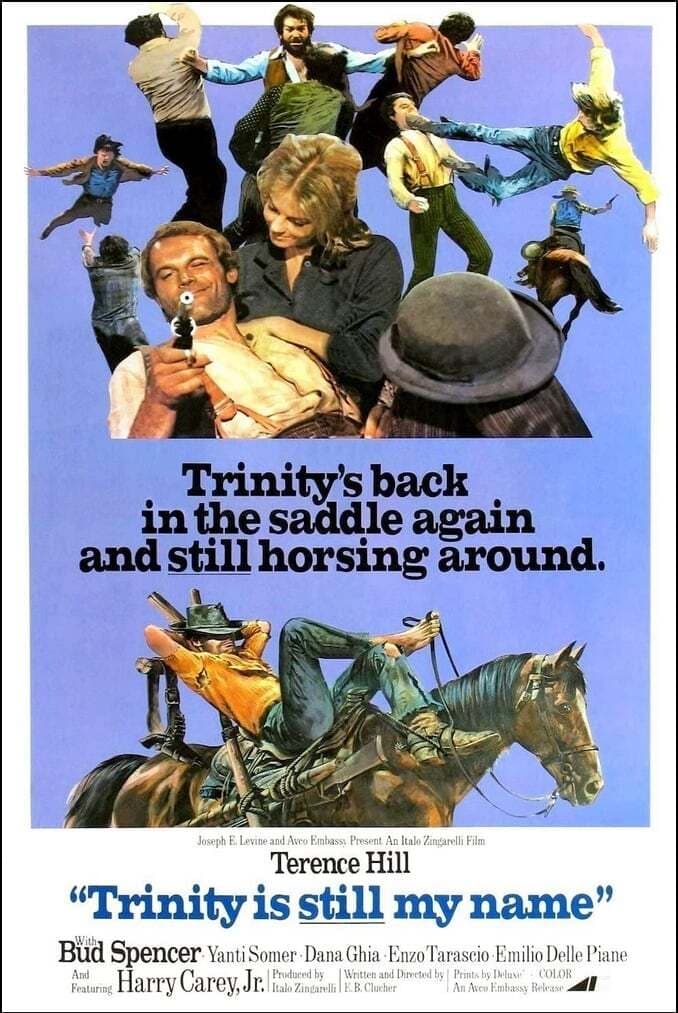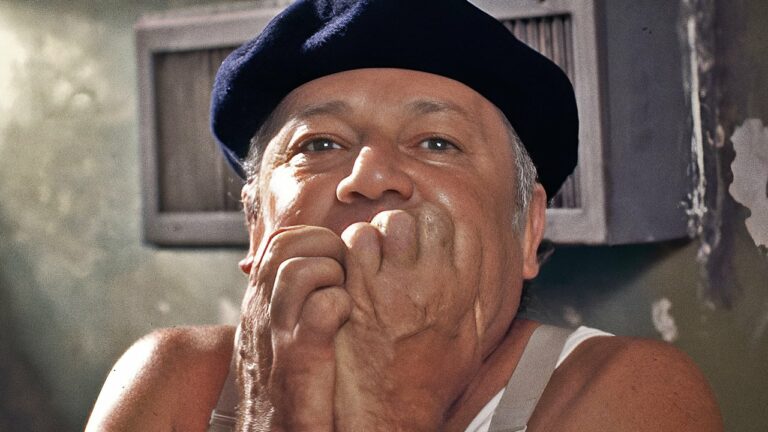
Mannaja: A Man Called Blade (Mannaja in Italian), released in 1977, stands as one of the last great entries in the Spaghetti Western genre. Directed by Sergio Martino, better known for his work in Italian Giallo films, Mannaja blends the gritty aesthetic of traditional Westerns with an atmospheric, almost gothic tone. Featuring Maurizio Merli as the titular Blade, the film is a violent, morally ambiguous tale of vengeance and survival, marked by striking visuals, a brooding atmosphere, and a haunting score.
As one of the final examples of the Spaghetti Western genre before its decline in the late 1970s, Mannaja carries a sense of nostalgia while pushing the boundaries of the genre with its darker themes and innovative cinematography. This article explores the film’s plot, themes, stylistic elements, characters, and its lasting impact on Western and Italian cinema.
Plot Summary: A Grim Journey of Vengeance and Redemption
The film follows Blade (Maurizio Merli), a stoic bounty hunter and master of the tomahawk, as he ventures into the corrupt mining town of Suttonville. Blade captures a notorious outlaw, Burt Craven (Donald O’Brien), and returns him to the town’s ruler, McGowan (Philippe Leroy), an iron-fisted landowner who controls the local silver mines and exploits the miners for his own profit.
While in Suttonville, Blade uncovers a web of corruption and violence. McGowan, despite being gravely ill, is desperate to hold onto his power, while his sadistic enforcer, Voller (John Steiner), spreads terror among the townsfolk. Blade’s arrival sets off a chain of events that reveals his personal vendetta against McGowan and Voller, stemming from the murder of his father years earlier.
As Blade seeks justice, he finds himself caught in a power struggle between McGowan, Voller, and the miners who are on the brink of rebellion. His path to vengeance is fraught with betrayal, moral dilemmas, and a reckoning with his own past. The film’s climax, set amidst the desolate and oppressive landscapes of Suttonville, is a brutal confrontation that underscores the moral ambiguity and violence that define the Spaghetti Western genre.
Themes: Darkness, Vengeance, and Corruption
1. Revenge and Justice
At its heart, Mannaja is a classic revenge tale. Blade’s quest for justice is personal, but it is set against a larger backdrop of systemic corruption and exploitation. The film explores how vengeance often comes at a cost, forcing its protagonist to grapple with the morality of his actions.
2. The Corrupting Influence of Power
McGowan and Voller represent the corrupting influence of unchecked power. McGowan, despite his failing health, clings to his authority at the expense of the miners, while Voller’s brutality embodies the moral decay that power can bring. The miners, meanwhile, serve as a symbol of resilience and the potential for rebellion against tyranny.
3. Isolation and Morality
Blade is a quintessential Spaghetti Western antihero: a solitary figure whose moral compass is as sharp as his tomahawk but often overshadowed by his thirst for vengeance. His internal conflict adds depth to the story, highlighting themes of redemption and the blurred lines between heroism and villainy.
4. Gothic and Apocalyptic Undertones
The film’s atmosphere, steeped in darkness and desolation, lends it a gothic quality. The constant rain, oppressive landscapes, and decaying town contribute to a sense of doom that permeates the narrative. This tone reflects the dying days of the Spaghetti Western genre, as well as the nihilism and despair that defined many of its later entries.
Characters: Complex Figures in a Brutal World
1. Blade (Maurizio Merli)
Maurizio Merli, best known for his roles in Italian crime films, delivers a commanding performance as Blade. His portrayal balances stoicism with flashes of vulnerability, making Blade a compelling antihero. Armed with a tomahawk rather than the genre’s traditional revolver, Blade’s unique fighting style and relentless determination set him apart from other Western protagonists.
2. McGowan (Philippe Leroy)
McGowan, the tyrannical ruler of Suttonville, is a multi-dimensional antagonist. While his exploitation of the miners makes him a despicable figure, his frailty and desperation to maintain control add layers to his character, making him more than a one-note villain.
3. Voller (John Steiner)
John Steiner’s Voller is one of the most memorable villains in Spaghetti Western history. Sadistic, cunning, and unapologetically evil, Voller serves as Blade’s primary nemesis. Steiner’s theatrical performance heightens the character’s menace, making him a standout element of the film.
4. Deborah McGowan (Sonja Jeannine)
Deborah, McGowan’s daughter, provides a counterbalance to the film’s violence and despair. Her compassion and bravery highlight the potential for goodness even in a corrupt world, and her relationship with Blade adds a touch of humanity to the story.
5. Burt Craven (Donald O’Brien)
Craven, the outlaw captured by Blade, is a morally ambiguous character whose shifting loyalties and role in the story mirror the film’s themes of betrayal and redemption.
Sergio Martino’s Direction: A Distinctive Vision
1. A Dark and Gritty Aesthetic
Martino, known for his work in Giallo films, brings a distinct visual style to Mannaja. The film is drenched in atmosphere, with constant rain, mud, and dim lighting creating a sense of foreboding that complements the story’s dark themes.
2. Inventive Cinematography
Cinematographer Federico Zanni employs dynamic camera angles, slow-motion sequences, and close-ups to heighten tension and immerse the audience in the action. These techniques reflect the influence of Sergio Leone while adding Martino’s unique flair.
3. A Blend of Genres
While firmly rooted in the Spaghetti Western tradition, Mannaja incorporates elements of horror and noir, particularly in its use of shadow and atmosphere. This genre-blending approach sets the film apart from more traditional Westerns.
Music: A Haunting and Experimental Score
The score by Guido and Maurizio De Angelis is one of Mannaja’s most distinctive features. Combining melancholic melodies, eerie vocals, and folk-inspired instrumentation, the music enhances the film’s haunting tone. The use of mournful ballads underscores Blade’s isolation and the bleakness of his world, creating a unique soundscape that lingers in the audience’s mind.
Legacy and Cultural Impact
1. A Late-Stage Spaghetti Western
By 1977, the Spaghetti Western genre was in decline, overshadowed by the rise of crime thrillers and other genres in Italian cinema. Mannaja is often regarded as one of the last great Spaghetti Westerns, serving as a fitting swan song for a genre that had dominated Italian filmmaking in the 1960s and early 1970s.
2. Influence on Neo-Westerns
The film’s darker tone and themes have influenced modern neo-Westerns, such as Quentin Tarantino’s Django Unchained and The Hateful Eight. Its blend of violence, moral ambiguity, and stylized visuals continues to resonate with filmmakers and audiences.
3. Cult Following
While not as widely recognized as some of its predecessors, Mannaja has gained a devoted cult following among fans of Spaghetti Westerns. Its unique approach, compelling characters, and memorable imagery ensure its enduring appeal.
FAQs
1. What is Mannaja: A Man Called Blade about?
The film follows Blade, a bounty hunter, as he seeks revenge against the corrupt rulers of Suttonville while confronting his own past.
2. Who directed Mannaja?
The film was directed by Sergio Martino, known for his work in Italian Giallo films.
3. What makes Mannaja unique among Spaghetti Westerns?
Its gothic atmosphere, innovative use of cinematography, and incorporation of horror elements set it apart from more traditional entries in the genre.
4. Who stars in the film?
The lead role is played by Maurizio Merli, with supporting performances by Philippe Leroy, John Steiner, and Woody Strode.
5. How does Mannaja compare to earlier Spaghetti Westerns?
While it retains many of the genre’s hallmarks, Mannaja stands out for its darker tone, innovative visuals, and experimental music.
Conclusion: A Gothic Spaghetti Western Masterpiece
Mannaja: A Man Called Blade is a standout entry in the Spaghetti Western genre, combining traditional elements with a dark and brooding aesthetic. With its complex characters, haunting music, and atmospheric visuals, the film captures the essence of the genre while pushing its boundaries.
As one of the final films in the Spaghetti Western canon, Mannaja serves as both a tribute to and an evolution of the genre, ensuring its place as a timeless classic in Italian cinema.






